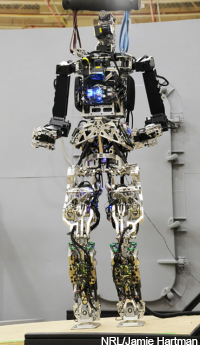Navy’s robot will interact with sailors, fight fires aboard ship
NRL and researchers from Virginia Tech and Penn recently demonstrated a humanoid robot, SAFFiR, that can work side-by-side with firefighters.
Fires aboard Navy ships can be damaging, dangerous and difficult to fight, particularly when they occur in confined spaces below decks. The Naval Research Laboratory is working on a way to help contain such fires without putting sailors at risk, by developing a humanoid robot to handle the job.
NRL’s Laboratory for Autonomous Systems Research (LASR) and research teams from Virginia Tech and the University of Pennsylvania recently held a demonstration to assess progress in their two-year-old program to develop advanced firefighting techniques using robotics.
The centerpiece of the demonstration was the Shipboard Autonomous Firefighting Robot, or SAFFiR, a humanoid machine designed to autonomously walk around a ship — with sea legs, accounting for pitch and roll — interact with people, check for structural anomalies and handle dangerous firefighting tasks.

SAFFiR has “seek and find” algorithms for locating a fire in an emergency and a suite of sensors including a camera, gas sensor and infrared and ultraviolet cameras that allow it to see through smoke and find heat sources, NRL said. Researchers also demonstrated smaller variations of SAFFiR, including a robotic arm that can, for instance, hold and activate a fire hose, and a smaller version of the robot itself.
Virginia Tech developed the robotic platform and fire-hardened materials used in the systems, Penn the algorithms for perception and navigation, and the Navy Center for Applied Research in Artificial Intelligence developed the cognitive models that allow the robot to interact with humans and work side-by-side with naval firefighters.

SAFFiR's sensors include stereo infrared and ultraviolet cameras that allow it to see through smoke and detect heat sources.
"These advancements complement highly specialized NRL research that focuses specifically on the human-robot interaction technology and shipboard-based spatial interrogation technology," said Alan C. Schultz, director of LASR and the Navy Center for Applied Research in Artificial Intelligence. "Developments made from this research will allow a Navy firefighter to interact peer-to-peer, shoulder-to-shoulder with a humanoid robotic firefighter."
With the demonstration in LASR’s controlled environment complete, researchers next plan to test their platform later this year aboard the ex-USS Shadwell, the Navy’s full-scale fire test ship.
One focus will be integrating the human-robot interaction with the SAFFiR platform, said John Farley, project officer for the Shadwell in NRL’s Chemistry Division. "In dark or smoke occluded and noisy environments found in shipboard firefighting conditions, tactile feedback — touch — is an important form of communication between human firefighters," he said.
As well, researchers at NRL's Advanced Materials Section have developed a lightweight, malleable resin that can hold its shape in temperatures up to 500 degrees Celsius (932 degrees F) and can protect the robot’s electronics and mechanisms in extreme heat.
Developing robots that can respond to dangerous emergency situations has taken the forefront of robotics development. Emergency response also is the focus of the Defense Advanced Research Projects Agency’s Robotics Challenge, which held a major competition in December and will conclude with a finals event later this year.
NEXT STORY: Classified NRO satellite readied for launch




